Helena Wu
語言:
English /// 中文
Translator: Enbion Micah Aan
Photo Credit: Helena Wu
IN JANUARY 2017, the Free Taiwan Party posted a Facebook status: “Pro-Independence takes a stand! Come pull down the Chiang Kai-Shek statue on February 28th at the Freedom Plaza!”
This year is the the 70th anniversary of the “228 Incident”, an “incident” that is still exceedingly painful for the Taiwanese. After the Republic of China government took over Taiwan after World War II, on February 28th, 1946, citizens rebelled due to its political corruption and ineffectual rule. The events went from the investigation of illegal tobacco to a bloody massacre when Chiang Kai-Shek deployed the military to overwhelm the populace. 70 years later, Taiwan’s native party (the Democratic Progressive Party) gained control of the executive and legislative branches for the first time in history, but Taiwan’s citizens are still unable to receive the complete and whole truth about the 228 Massacre. Over the years, memorial events around the massacre have centered on only the victims, hiding away those who bare the responsibility of the massacre and still face no accountability.
The Free Taiwan Party, founded by Professor Tsay Ting-Kuei, is a political organization that is the closest to independence in the political spectrum between independence and unification. As the Facebook status noted, “All over Taiwan, Chiang Kai-Shek, with hands full of Taiwanese blood, is still seen as a ‘historical leader’, with statues of Chiang erected to be worshipped. The fact that these bronze totems that symbolize authoritarianism are still around means that transitional justice is just starting, and not even half a step has been taken towards justice.”
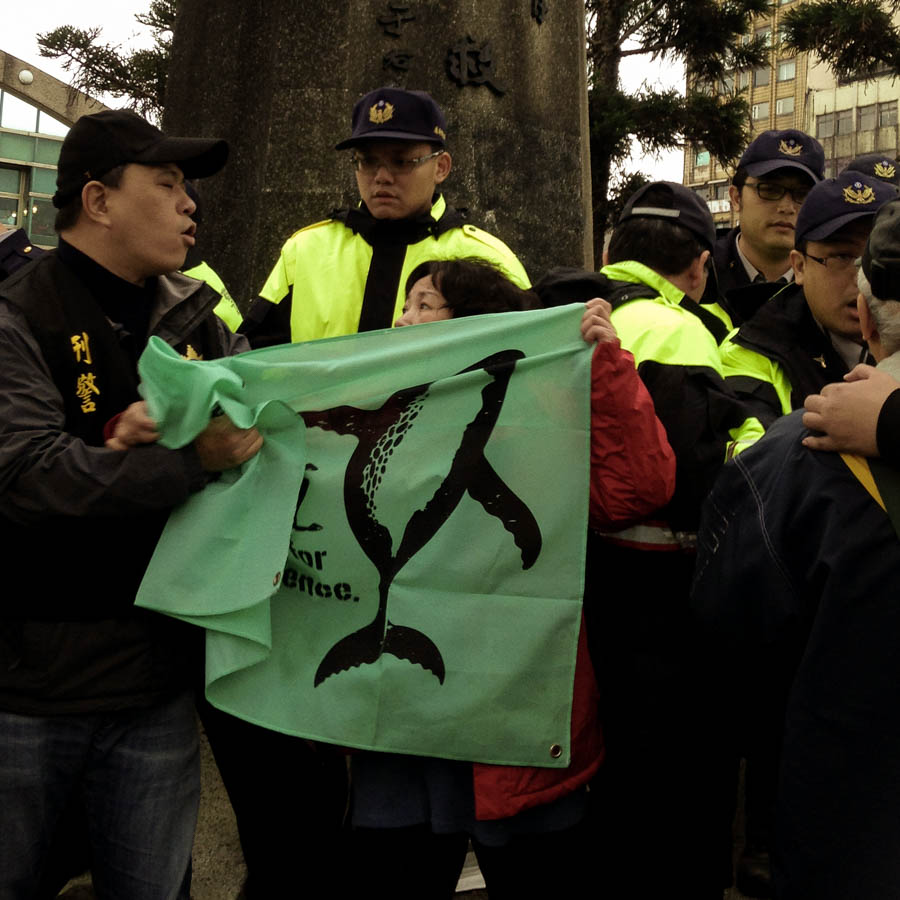 Photo credit: Helena Wu
Photo credit: Helena Wu
In Tainan, there is a memorial park dedicated to the human rights attorney, Tang De-Jhang, a innocent victim who was murdered by the ROC government, and the park was built at the precise location of his execution. However, a bronze statue of Sun Yat-Sen (the founder of the ROC) was erected in Tang De-Zhang’s memorial park—this is yet another propaganda statue made by the oppressors to mythologize its authoritarianism. Faced with such an absurdity, Tsay Ting-Kuei, along with many supporters of Taiwanese independence pulled down the statue of the “Oppressors’ Founding Father”, and spray painted “ROC OUT” on the bronze statue.
Oppressors have always ruled over the oppressed on this island. It is as if the Nazis were still in charge, burying their history of genocide, and built a memorial for Hitler. Taiwan’s most absurd existence is no less than that of the Chiang Kai-Shek Memorial Hall at the Freedom Plaza.
With KMT’s perennial mythology instilled in its propaganda education, it became possible for Chiang Kai-Shek, the butcher, to become Chiang Zhongzheng, [1] the Savior of the Nation. There is a song, “In Commemoration of Chiang Gong”, [2] praising him as “the lighthouse of freedom, and the Great Wall of democracy”, whilst he is responsible for prohibiting freedom of speech and thought, not to mention his complicity in White Terror. This former President was never elected through the democratic procedures, and, as he was above the constitution, he was able to serve unlimited number of terms. Yet this very song still plays daily when the Memorial Hall opens and closes.
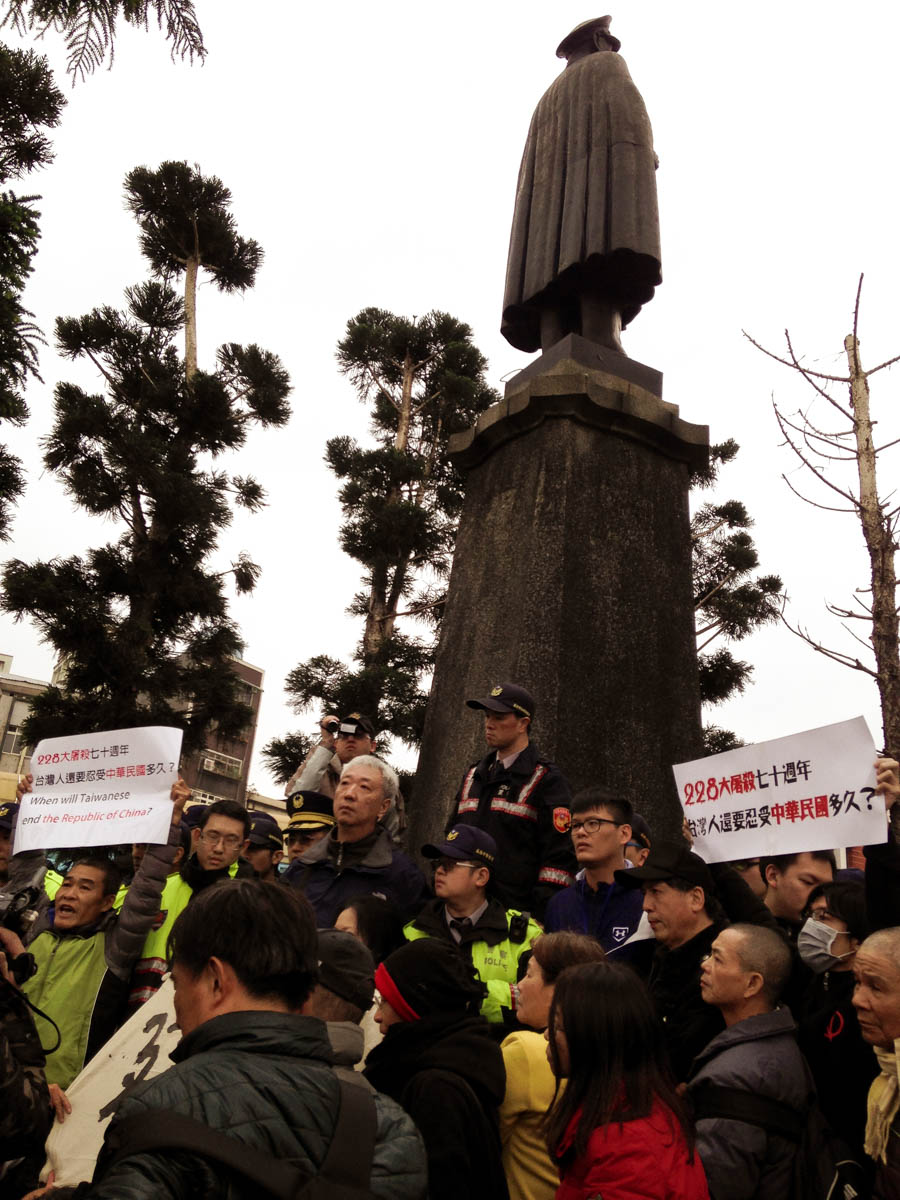 Photo credit: Helena Wu
Photo credit: Helena Wu
Tsay Ting-Kuei was imprisoned for pulling down Sun Yat-Sen’s statue in Tainan, and while serving his sentence in prison, he decided to pull down the largest of authoritarian statues: The 6.3 meter (22 feet) bronze statue of Chiang Kai-Shek in the Memorial Hall. After his prison term, Tsay called on all pro-independence groups to pull down the bronze statue, but as the information was released in a completely public manner, the effects triggered far exceeded all participants’ anticipation.
As a young supporter of Free Taiwan Party and a supporter of the action of pulling down authoritarian statues, I documented and witnessed the actions on site during this time.
February 27th, 2017: In front of the Keelung Train Station
WITHIN THE traffic circle in front of Keelung Train Station, the elevated statue of Chiang Kai Shek is partially hidden amongst pine trees. Around noon, participants of the action gradually arrived, only to see a large number of police surrounding the statue. The plan was to be executed before 228, to charge in unexpectedly in order to pull down the statue, but judging from the presence of the police, the information had already leaked .
Even so, the action was not delayed. Professor Tsay Ting-Kuei along with other participants crossed the streets from all directions, rushed to the base of the bronze statue and shoved against the police. Tsay sat on the floor, and supporters surrounded him with banners that read “Why worship a mass murderer?”, “228 culprit. Transitional justice can’t wait”, “70th anniversary of 228—how much longer will Taiwanese have to tolerate the Republic of China?”, and other demands.
When participants took out ropes and other tools, the police rushed to grab the tools, pushing people towards the streets. Once on the streets, protesters used the ropes to block traffic, and the group now sat on the floor. After some shoving with the police, protesters were able to occupy a few lanes.
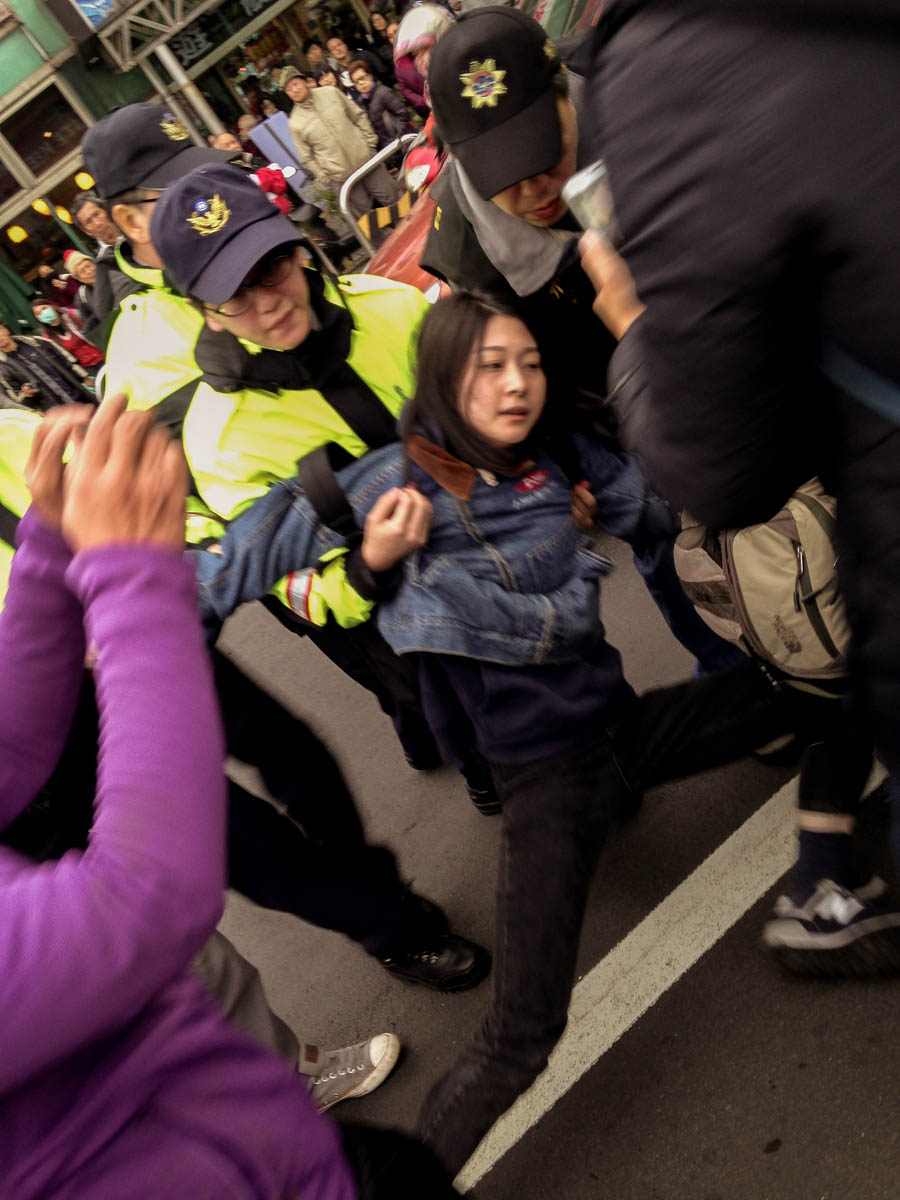 Photo credit: Helena Wu
Photo credit: Helena Wu
In the process of blocking traffic, the police said, “We are protecting you, and we are here for your safety”, and the protesters angrily responded, “Who do you protect? You’re protecting the bronze statue!” When drivers complained about the blocked traffic, some demonstrators yelled back, “We are sorry, but it is the police who would not let us pull down the statue, forcing us to block the traffic.”
We, who were in solidarity and on site to support the action, linked up our hands and sat on Keelung streets. Next to us, we had a banner stating, “Do not forget Keelung Massacre.” The massacre from 70 years ago started in Keelung, indiscriminate shooting killed and seriously injured people of Keelung. How many people died unjustly on the very road we now occupied? But now, people of Keelung were angry for blocked traffic.
Keelung’s humidity and chill slowly infiltrated our bodies.
The action paralyzed traffic and lasted 4 hours. In the end, the action ended after Assemblyman Chang Jin-Jia responded by promising to communicate the demands to Keelung Mayor Ling Yu-Chung, who was out of the country at the time.
After the action, the Free Taiwan Party, on its Facebook page, posted, “If Keelung City will not proactively remove the statue of Chiang Kai-Shek, we will be sure to resist more intensely. We hope that Mayor Lin Yu-Chung will remember DPP’s promise for transitional justice during the election, will not let a statue of a mass murderer stand in this afflicted city, and never allow such atrocities again in Taiwan.”
February 28th, 2017: Freedom Plaza
WITH ITS BLUE sky, white day, and red ground (青天白日滿地紅), the ROC flag fluttered around in front of of Chiang Kai-Shek Memorial Hall. [3] On the day that the Free Taiwan Party publicly called on pro-independence groups to participate in the action of pulling down the bronze statue, KMT and pro-unification supporters already gathered here and pledged to protect the statue. They loudly sang the ROC national anthem and pulled up the half-raised flag, even though 70 years ago today, the “red ground” of the flag was ground full of Taiwanese blood.
Tourists walked on the white steps, oblivious of the tension on site, taking selfies at the top of the memorial, and did not care about the closed door in the background. The evening before, the Ministry of Culture announced that going forward, the memorial will be closed for one day on February 28th to avoid social conflict . This made the task of pulling down the statue impossible.
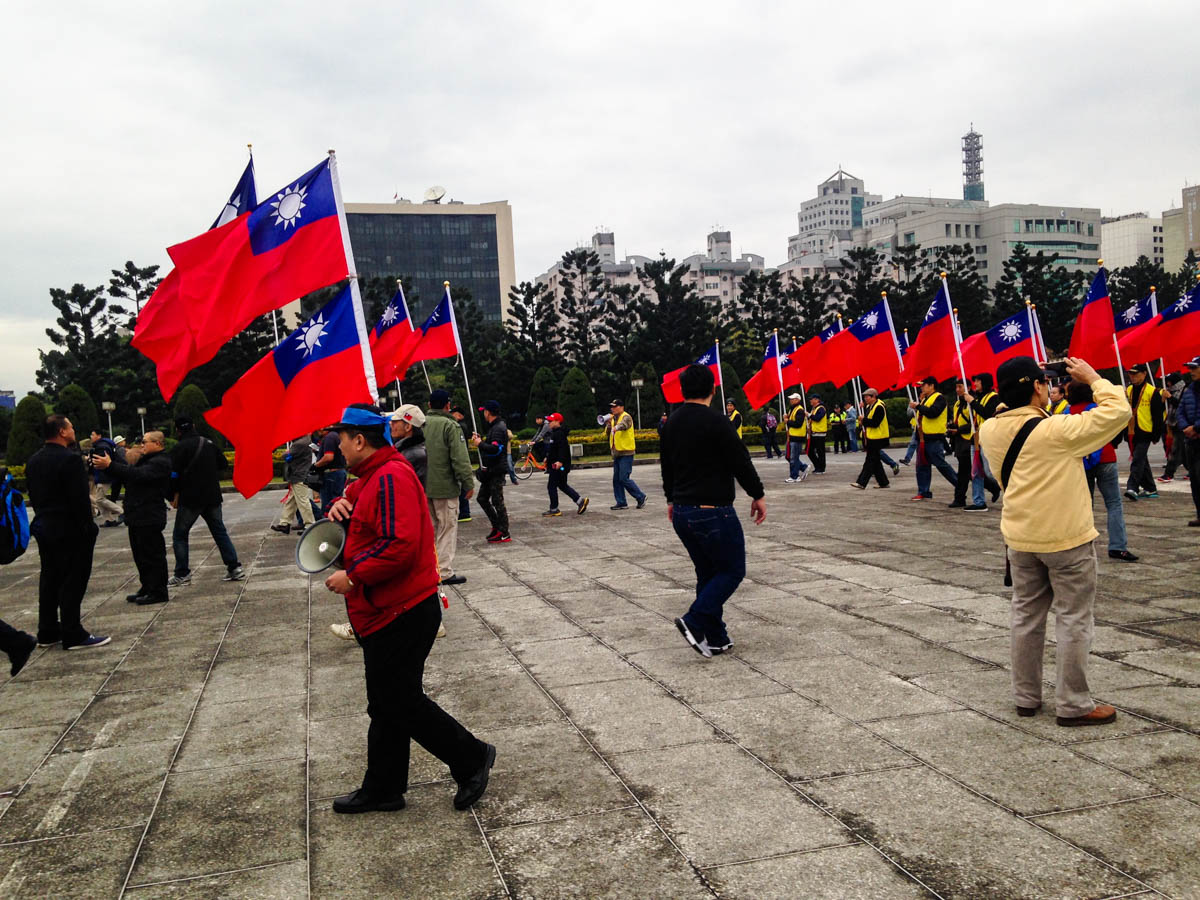 Photo credit: Helena Wu
Photo credit: Helena Wu
However, on the evening before the action, Professor Tsai Ting-Kuei and leaders of other groups anticipated this, and they decided to still move forward, changing the action to a non-violent symbolic one on the stairs of the memorial.
At noon, at the planned time, Tsay and other pro-independence groups held high “Taiwan Independence” flags and gathered at the Freedom Plaza, outside of the Memorial. On site, a large group of police and KMT and pro-unification supporters, holding the ROC flag, were already there.
During Tsay’s speech in the press conference, many pro-unification groups were yelling and waiting for an opportunity to cause trouble. When the team was ready to march, the police with their shields lined up to block the march, ironically limiting personal freedom at Freedom Plaza.
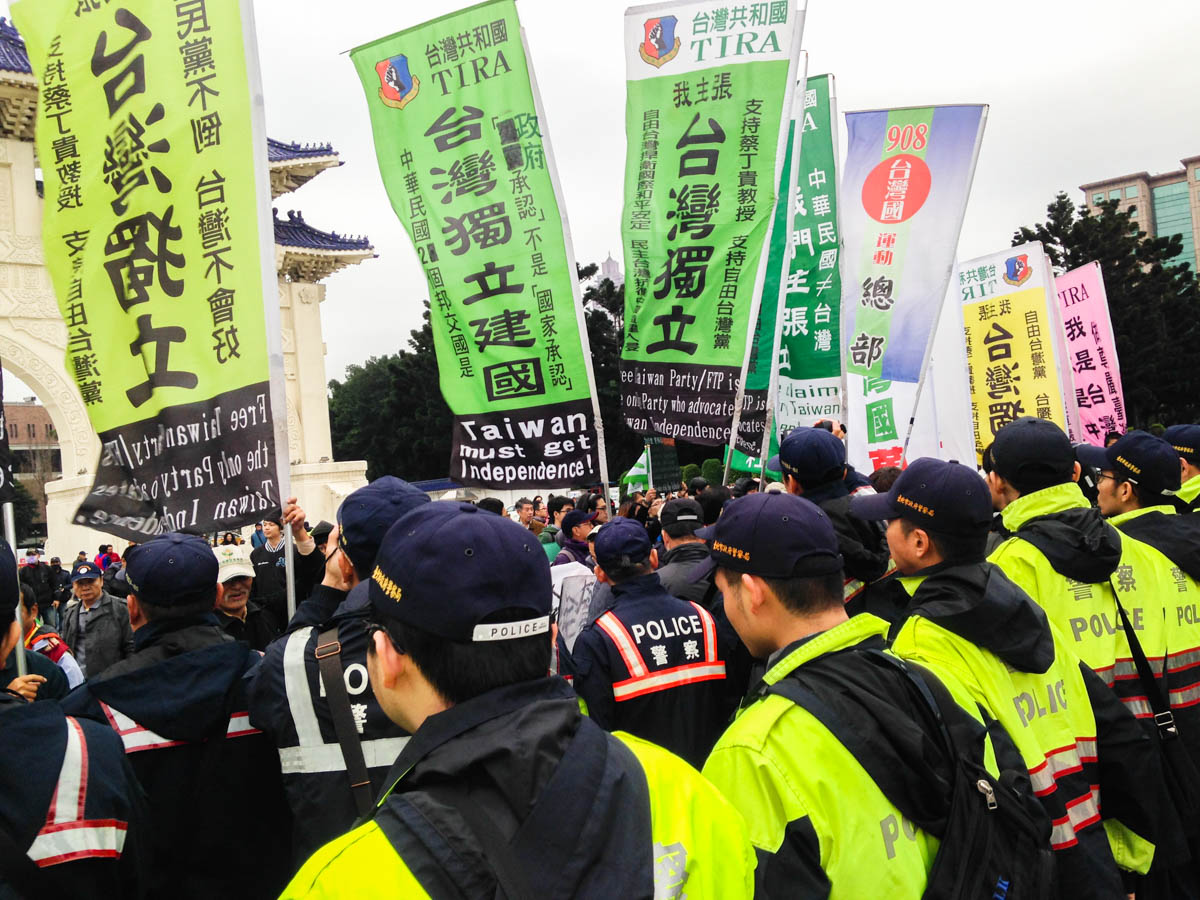 Photo credit: Helena Wu
Photo credit: Helena Wu
Due to the stalemate between the protestors and the police, a small number of participants were able to walk in from the two sides. Unable to hear instructions, they marched as planned. And those pro-independence youth who walked in, under the gaze of the police, ushered in the most unimaginable encounter during the action.
During acts of resistance, key moments are often fleeting, and I might not have understood immediately what transpired after. It was only later when I was at the police station that I was able to reconstruct the scene.
I and a few other partners walked into Freedom Plaza, and one of them was wearing a pro-independence whale flag. A few people bearing the red vests of “Advancement for Unification Party” walked towards us and said, “How dare you walk here?” and spoke to us with intention of provoking us. However, we generally ignored them.
Suddenly, members of the Unification Party grabbed our partner Cheng’s pro-independence flag, and instinctively, I started recording with my cellphone. I saw, through recording, that Cheng was being chased and beaten up by quite a few red vested individuals. At the same time, I heard more commotion, and when I turned the camera, I was shocked to find that Yu was on the floor, and the Unification Party members were pulling her hair and beating her to the ground, surrounding her and yelling insults.
Photo credit: Helena Wu
Perhaps due to the impact of what happened right in front of me, I do not remember how we left the site, and I only remembered to upload the video online. Later on, we returned to the stairs at Freedom Plaza. Tsay, blocked by the police from entering, executed the planned action there, burning the ROC flag and gold paper. [4] Giant banners stating “228 mass murderer is here” in both Chinese and English were hung at the gate, and rotten eggs were thrown at the memorial.
The group took off the banners, and the procession of the giant banners followed Tsay to the 228 Memorial Park where commemoration of 228 was held at the same time. Tsay decided not to bring back the banners and wanted to burn them in the park. The nervous police again surrounded him, but Tsai threatened that if the police attempted to stop him, he would jump into the fire. While the police started raising signs and issuing warnings, Tsay poured gasoline on the banners and started the fire.
Yu and I did not wait till the end of the action, since we had to go to the hospital to have her checked out and to report the incident to the police.
 Photo credit: Helena Wu
Photo credit: Helena Wu
“Oh, so you went to a protest!”, the police who managed our case, were initially, quite indifferent and frequently wanted to lead us, “Did you walk into ‘their territory’?”. Angrily, I responded, “What territory? We were just walking in Freedom Plaza, and everyone can walk there!” (There were tourists there at the same time.) This is not to mention that we were actually quite far from where they had gathered.
When we played the video from the cell phone to ascertain the crime scene, our partner’s screaming permeated throughout the office at the police department. The police, believing the perpetrators had the kind hearts of Buddha, said, “This Ah-bei saved you!”, while the video was paused at the moment the Ah-bei grabbed her flag. [5]
As the truth slowly revealed itself through each passing image, the police’s attitude changed. Yes, we did nothing. We were merely wearing Taiwan independence flags, walking on the Freedom Plaza that belong to the Taiwanese people, and the flag that bears our ideals was forcefully taken from us, and our people were beaten up.
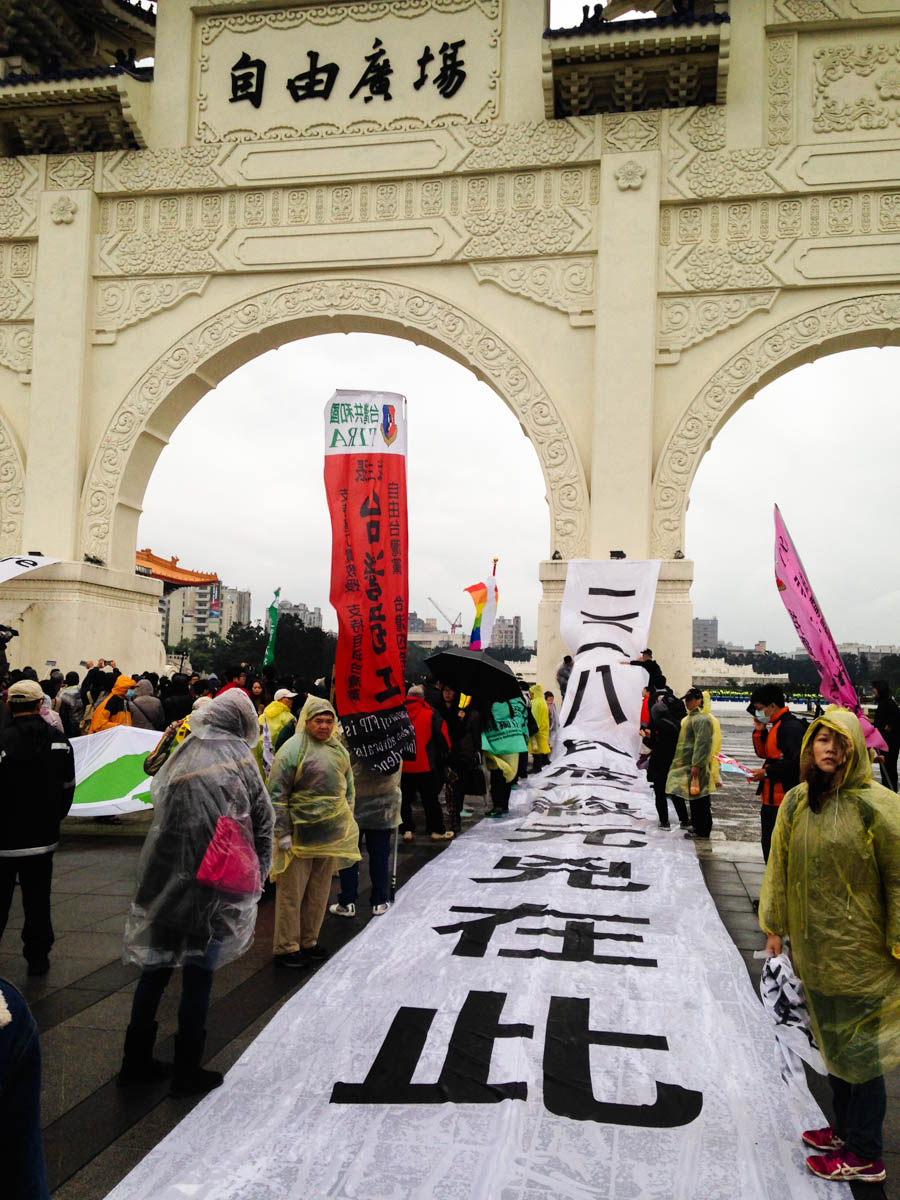 Photo credit: Helena Wu
Photo credit: Helena Wu
The preconceived notion of pro-independence is that pro-independence is violence. Even the President’s Office once proclaimed that pro-independence actions are “violent acts against violence”. However, pulling down statues, blocking traffic, and burning symbols are all strategies of nonviolent resistance. The juxtaposition on this day in which pro-unification people not only beat up pro-independence people, but also forcefully took personal property, held knives to threaten people, and went as far as punching the police. Their actual actions proved what real violence is.
The behavior of unification supporters has not changed since 70 years ago. That is, the nature is a very “Chinese” style of violence. What happened on this day is like a repeated action of historical tragedy, opening up the deepest wounds of Taiwanese people. Seeing the actions of pro-unification people, most agree that, if had they had guns, they would undoubtedly again, without hesitation, fire bullets on Taiwanese people. When pro-independence youth were beaten up, the police would not arrest the perpetrators on site and were even unwilling to identify the individuals. When she posted about what happened on Facebook, someone left a message saying, “This is not your country.”
Much like how authoritarian terror was never condemned, the existence of evil and violence is silently condoned and respected. The police’s selective enforcement of justice explains all.
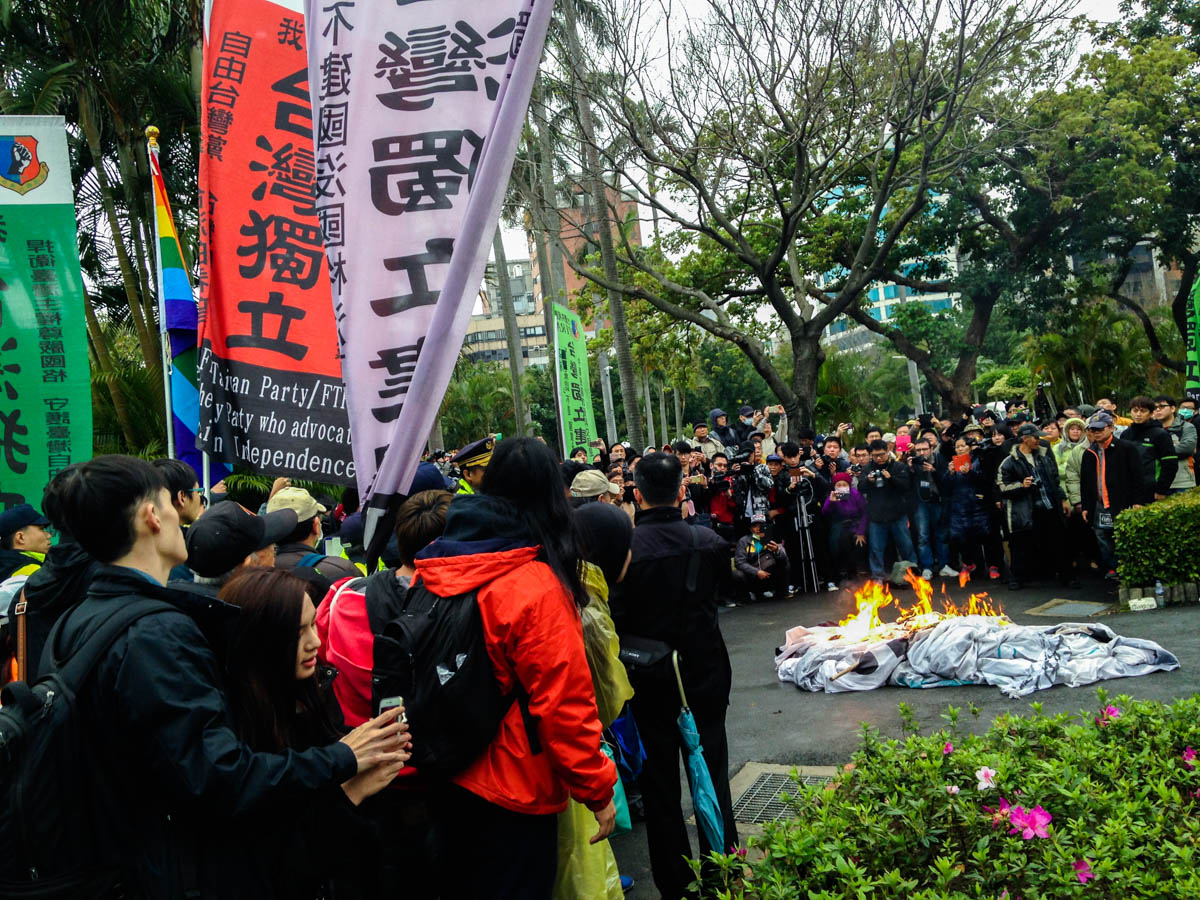 Photo credit: Helena Wu
Photo credit: Helena Wu
As the video I uploaded has been viewed 120,000 times, there were two polar opposite reactions to China Unification Promotion Party’s violent behavior. Most believed in holding perpetrators accountable, and held thorough understanding of implication of “unification”. While some were angered by the violence, leading the conclusion of advocating for an armed response. But how would we oppose the violent rule of the Chinese and use violence as a tactic ourselves? Violence is not to be legitimized. As we choose the path of having our nation that is separate from China, nonviolence is extremely difficult, but it is the only way.
Judging from opinions from all walks of life, Taiwanese people are generally psychologically still living under martial law. For example, some would say “They will be scared if you punch them back.” Or, some would argue that the act of violence against people holding opposing views is also merely an act of expressing their demands. “As long as society’s orders are not destroyed”, it really does not matter. Therefore, the media, knowing people’s standards, make the “Pro-unification people beating up people” and “Pro-independence people burning flags” criminally equivalent.
If growing up, the education we receive is: as long as it is from the authority, you can be beaten up and killed, and having your personal properties forcefully taken from you, and there will be no trials, not to mention accountability, how can we possibly comprehend the meanings of “human rights”? And what is “justice”? After all, in Taiwan, those who committed crimes against humanity can be considered great leaders of the world.
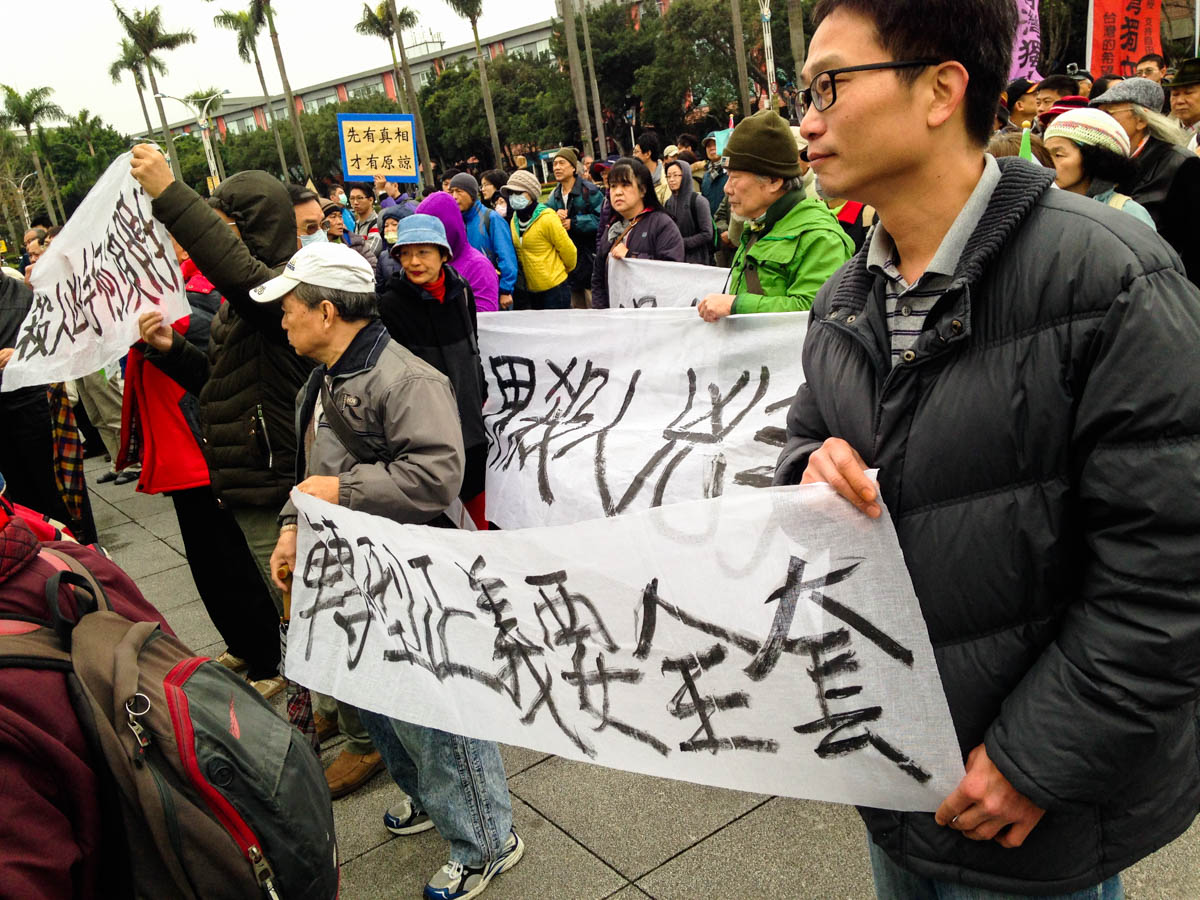 Photo credit: Helena Wu
Photo credit: Helena Wu
When I wrote “Transitional Justice Must be Complete” on the banner, it reminded me that the earliest 228 marches were organized by Cheng Nan-jung, who later committed self-immolation to defend the freedom of speech. He once wrote:
“Because the damage of ‘228 Incident’ sank down to the bottom of every person’s heart on this island, and there, it quietly fermentates and metamorphosizes, every spirit is eventually polluted, and this distorted everyone’s belief in democracy and moral values. And so, Taiwan, as a society eventually came to the point of having no confidence for the future and lacked the deep identification towards the land.”
— Freedom Times Magazine, Issue #159
March 8th, 2017: Memorial at the Keelung Ocean Plaza
AT THE KEELUNG Ocean Plaza, the memorial was to start at 2:28. Again, on a humid and chilly rainy day, the pre-arranged chairs formed barriers, with security personnel separating the passers-by from the memorial. From speakers, the light music sounded like that of a cafe.Do these people in Keelung understand what they were “memorializing”?
70 years ago, on this very day, KMT’s military started the massacre here in Keelung. They started shooting before landing, indiscriminately killing men, women, and children. Wires were forced through Taiwanese people’s palms, making rows of people, whom they threw in the ocean. Or they were bagged in sacks and thrown in the ocean. The blood dyed the water red…
This is what actually happened on March 8th.
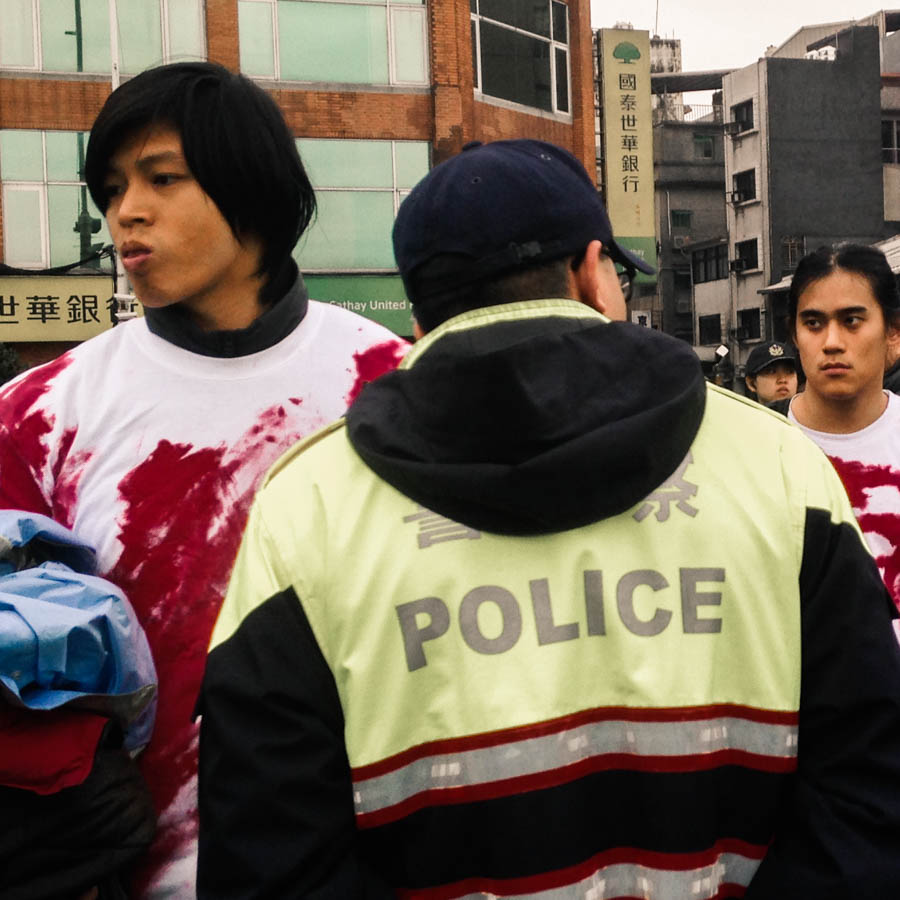 Photo credit: Helena Wu
Photo credit: Helena Wu
Even with the actions from these few days, Keelung Mayor Lin Yu-Chung, upon his return to Taiwan, would not consult on the statue. The Free Taiwan Party and its allies must act. However, with a limited time frame and the urgency of the situation, pro-independence youth pushed for different ideas.
There was significant police presence at the memorial. Lin, Keelung’s mayor arrived, and Tsay also arrived in a speaker truck*. Soon after he entered the memorial, the speaker truck started broadcasting alarms. Our partners and I immediately took off our jackets, revealing our white t-shirts with bloody words on them, yelling “The KMT is coming!”, “The KMT killed people!”. We screamed and ran.
The action/theater planned by pro-independence youth does not, in fact, come anywhere close to the actual terror experienced at the time, but with so much police presence, many could not even take off their jackets before being restrained. There were some who fell due to police suppression, and they were bleeding from the head, making the theater unexpectedly realistic. At the end of action/theater, everyone fell to the floor. Still panting, I stared at Keelung’s gloomy sky, wearing a shirt with the bloody character of “Injustice.”
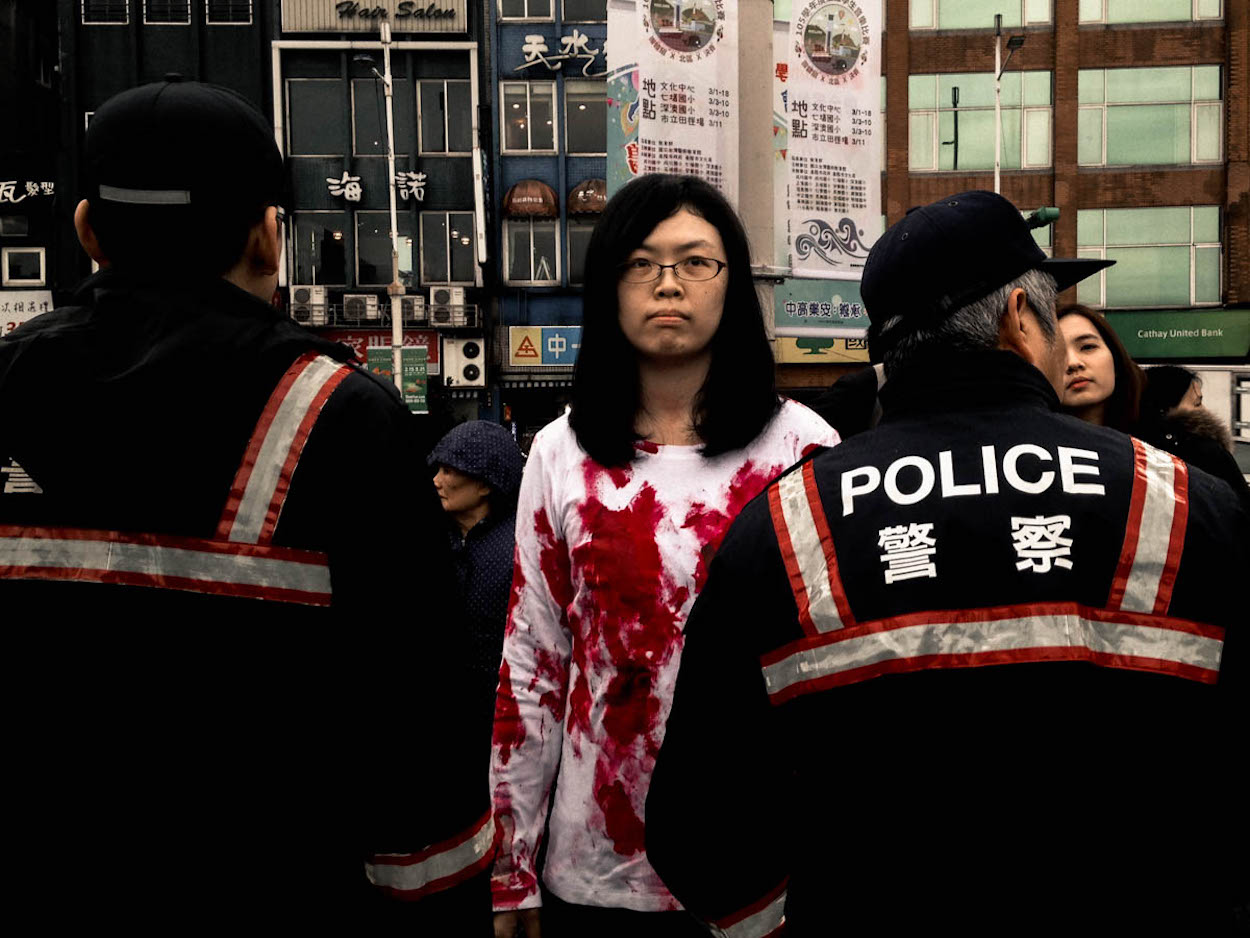 Photo credit: Helena Wu
Photo credit: Helena Wu
The young people got off the floor, and Tsay and supporters wanted to hold banners in protest, but they were blocked and pushed by the police. Then the team left and moved to Keelung Station, and again, at the station, the group wrestled with the police because they were not able to cross the streets to get to the bronze statue. Instead, the group was led to circle the traffic circle, and the march stopped in front of the bus station when the police had the group completely surrounded, making it impossible to enter the city limits of Keelung. After several stalemates and tussling with the police, and after the pro-independence youth’s representative clearly expressed their demands, the end of the activity was announced.
While I laid on the floor, a few drops of rain, like tears, dropped into my eyes.
Perhaps the weather was the same. It was the 70th anniversary of “228 Incident” after all. Was it not like this then? Covered by the gray fog and rain, with a chill that penetrated hearts, I thought of the Taiwanese people who were killed unjustly on that day.
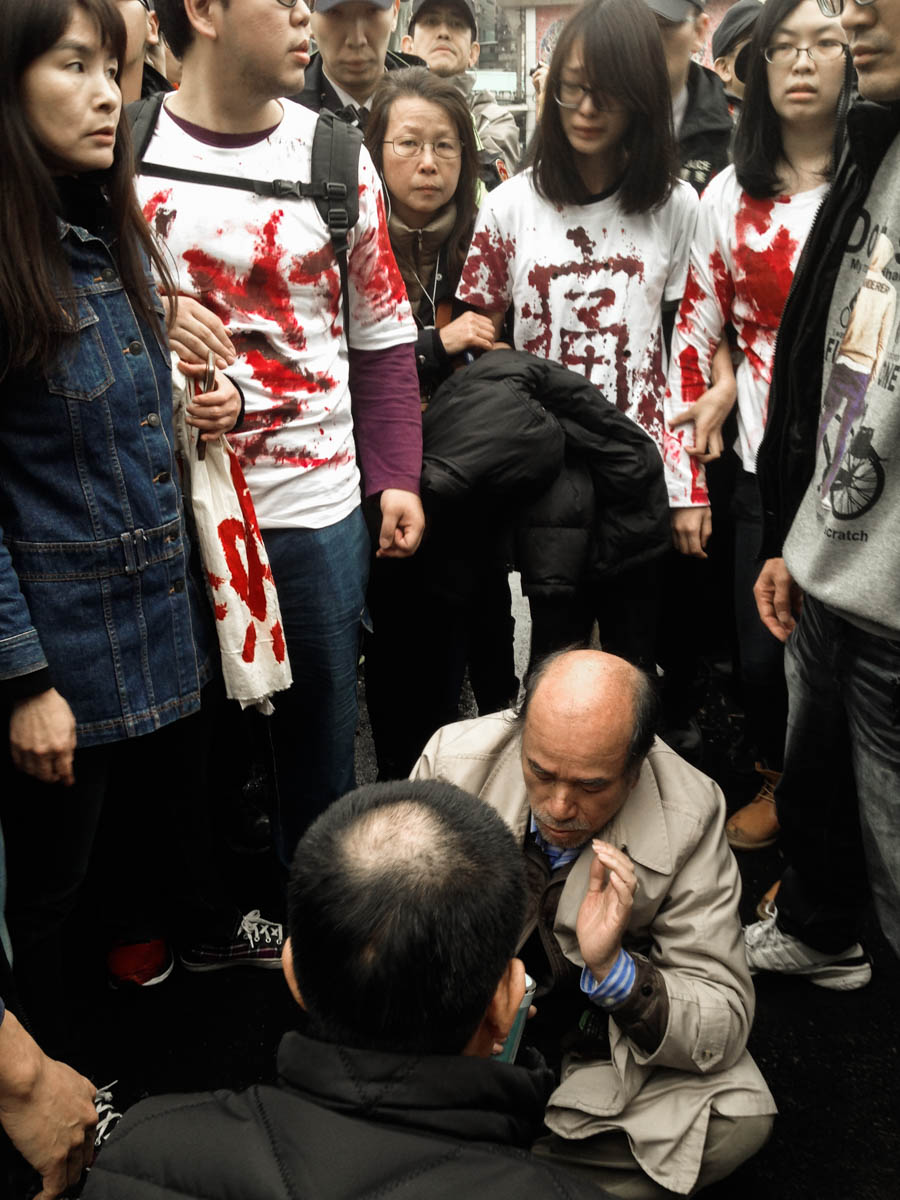 Photo credit: Helena Wu
Photo credit: Helena Wu
They were shopkeepers, they sold fish, or were farmers, or workers. Perhaps, they were only on the way to work, meeting with friends, or buying food for xiaoye. They were not armed and they were not able to resist. They were everyday people. Maybe some of them had been small town mayors. Maybe some stopped soldiers from using classroom chairs as wood. They were just living a normal day, leaving the house as usual, and then they were gone.
70 years ago, some of the worst things happened to the best people. 70 years passed, and their stories still have not been written onto textbooks, and their murderer who massacred them sits high in a memorial.
 Photo credit: Helena Wu
Photo credit: Helena Wu
I thought, why is it that injustice has never left Taiwan’s society?
The victims are not just those who passed. Taiwan as a whole is a spirit of injustice.
Let this rain last through day and night.
[1] Kai-Shek is Chiang’s zhi (字), Zhongzheng is his ming (名). Ming and Zhi are an archaic usage of names, ming being the formal name and zhi being informally name. One would be expected to call someone by their zhi, as ming would be considered too direct and offensive. Here, the disrespect in this article is intensional.
[2] In an effort to propagandize and mythlogize Chiang Kai-Shek, the name ”Chiang Gong” (蔣公) was bestowed to Chiang after his death by law, it was also legally required for official documents to use this name, as well as taito (抬頭). Taito is an archaic honorific that essentially means to leave a space before the name (in Chinese, characters do have have spaces between them where there is no punctuation). But it is an honorific that is so reserved that even Confucius and God would not require such an honorific.
Chiang (將) is used throughout for sake of continuity. It is more common to spell Chiang’s name as Chiang Kai-Shek (or Jiang Jieshi) , Jiang Zhongzheng, and Jiang Gong.
[3] Textbook description of the Republic of China flag.
[4] Gold paper is burned during funerals and prayers. Here it is used to symbolize the ROC’s “death”.
[5] Ah-bei is a term of endearment used to describe an elderly male.

